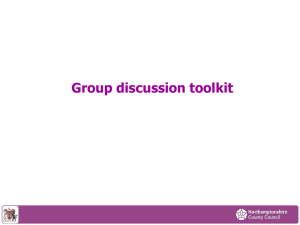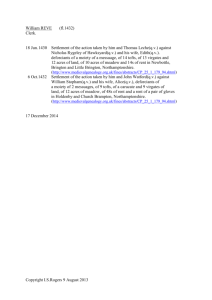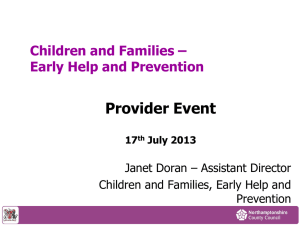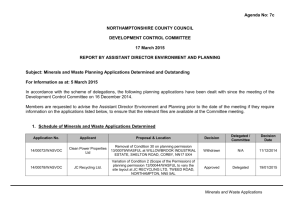Demography needs assessment Executive Summary finalv2
advertisement
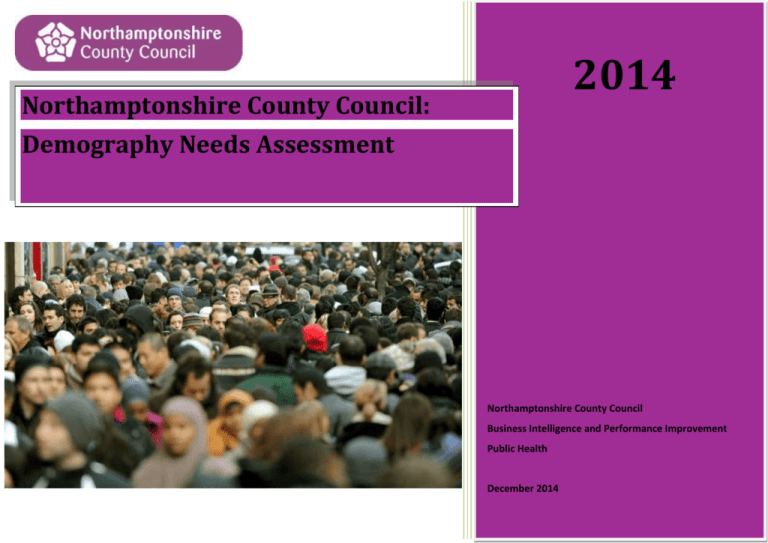
2014 Northamptonshire County Council: Demography Needs Assessment Northamptonshire County Council Business Intelligence and Performance Improvement Public Health December 2014 Executive Summary The Demography Needs Assessment for Northamptonshire is designed around a central objective of identifying the public health needs of the area’s population. To achieve this, an understanding of the demography of the county is critical. Who the population are, where they live, and how these factors influence their lifestyle, life choices, and risk of developing specific conditions or diseases, provide significant intelligence for the management, reduction and treatment of prominent, escalating and recurring health issues within Northamptonshire and its various communities. The remit of this demographic overview is to provide the context in which public health intervention and support should be designed. A number of the most prominent and intensive clinical needs are the result of social and spatial forces, linking individual and collective health and its precursor of wellbeing to social and environmental factors. Some of these are embedded in behaviours themselves reinforced by socioeconomic and cultural phenomena; others are more directly associated with social and environmental conditions. Variations in community and individual wellbeing, and therefore health, can be present at highly localised levels. Public Health in Northamptonshire is contextualised by more than simple spatial definitions. Also of key importance is the policy environment and defined priorities, determined through formal documents published by national and local strategic agencies and partnerships. These policy priorities represent clinical demands and projections in relation to prevalent conditions, linking them to risks associated with specific social groups. The presence of these groups within Northamptonshire forms the basis for this demographic analysis. Potential Commissioning Implications and Recommendations The Northamptonshire population is predicted to substantially rise over the next 16 years by almost 100,000 people – as life expectancy increases consistently and births exceed deaths the population increases in size, also fuelled by migration to the county. Recommendation: Commissioners need to be aware that the demand for services is going to increase and should develop proactive strategies around access to services. The population of old people (65+) has been increasing and is going to continue to do so – This results in higher levels of Dementia, more old people living on their own and more informal carers. Recommendation: Services aimed at supporting older people need to be focused around prevention as much as possible. Diagnosing Dementia early should be a key priority as diagnosis rates are 59.37% in Nene CCG meaning many people remain undiagnosed. The number of looked after children has been increasing consistently for around a decade – nearly half of these cases are due to abuse or neglect. Recommendation: This specific demographic group needs to be carefully monitored. It could represent potential young people leaving care with high health and wellbeing needs and poorer health outcomes. Significant inequalities exist between the best and worst performing areas of Northamptonshire – It is clear that there exists a large difference in life expectancy depending on where you live in Northamptonshire. South Northamptonshire consistently has lower age standardised mortality than all the other districts for example, and this is gradually decreasing over the period. At the other end of the scale Corby consistently has the highest age standardised mortality, followed by Northampton (which actually worsens over the period). These varying age standardised mortality rates demonstrate the inequalities that exist within the population: where people live can have a large bearing on health outcomes in their lives. Socioeconomic deprivation is highest in Corby, followed by Northampton and then Wellingborough. Recommendation: To address the inequalities in health outcomes across the county’s areas of concern should be a priority, particularly in urban areas like Corby and Northampton. Northamptonshire is become more ethnically diverse – This is illustrated in the changing ethnicity breakdown of the 2011 Census. New trends are becoming apparent in terms of languages spoken in schools other than English, such as Polish, Bengali, Romanian, Lithuanian and Somali. The size of BME groups is increasing. The numbers of births to mothers from the new EU entrant countries are increasing. Recommendation: The health and wellbeing needs of ethnically diverse and multi-cultural populations need to be considered in full and information and advice provided at critical points in someone’s transition. Health Policy in Northamptonshire As a part of England, health intervention priorities within Northamptonshire are shaped by a set of nationally-situated policies set by the Department of Health. As at September 2014 there were 7 distinct policies specific to public health; whilst set out individually, these are not mutually exclusive and a number are inter-related. In addition, a number of locally specific policies have been developed by the Northamptonshire Health and Wellbeing Board to address issues identified as of significance within the county. Within these, specific groups are either identified or inferred with regard to tendencies toward such issues. Principal Health Policies: National and Local Department for Health Northamptonshire Health & Wellbeing Board Giving all children a healthy start in life Increasing rates of breastfeeding Reducing drugs misuse and dependence Reducing levels of childhood obesity Helping more people survive cancer Tackling alcohol and drug issues to protect communities and improve lives Reducing smoking Improving prevention, treatment, and care in the community for frail and elderly people Reducing obesity and improving diet Improving the quality of life of vulnerable older people Planning for health emergencies Reducing harmful drinking Alongside these public health priorities sit a set of clinical ones relating to specific diseases and conditions. Whilst seeking to ensure high quality clinical care for all, this also integrates with public health needs through the identification of social groups with increased risk of experiencing such health issues due to cultural, environmental or genetic factors. Key demographics beyond the collective Northamptonshire population are identified as deprived communities, Children, Young Adults, Older People, and a diverse set of Minority Groups. Key Public Health Demographics in Northamptonshire Northamptonshire’s Population POPPI/PANSI 2014 Population Predictions Northamptonshire’s population stands at around 706,600 as of 2013. Whilst population density is relatively low, the county has grown at a fast rate over the past 30 years, well in above national or regional trends, increasing by around one third. Alongside this growth has come significant restructuring of the population. As groups such as those aged 65+ and BME communities have seen a large increase, amongst others this has been more modest, affecting the balance of the population. In spite of this restructuring, the representation of such groups remains comparatively low against the national profile. Northamptonshire’s proportion of residents aged 65+ is lower than the national rate whilst for those aged 16 and under the share stands higher. Locally, the dependency ratio – the number of residents of working age in comparison to those outside of this range – is marginally higher than for England, the 16-64 population representing a proportion of the population 0.5% points lower. Further restructuring is predicted to occur during the period to 2021 and 2030, with population expected to reach 770,000 in 2020 and between 810,000 and 870,000 by 2030. Certain forms of restructuring are expected to occur through cyclical tendencies of natural change, such as a sequential rise and fall of births over time influenced by socio-economic conditions. This will affect the distribution of the population as these waves are represented within age groups. Additionally the issue of accumulating linear shifts, such as longevity and migrant growth, will contribute toward more significant restructuring. The number of residents aged 85+ locally is expected to have grown by 25% by 2021, and the migrant population is nationally projected to rise to anywhere between 10% and 40% by 2050. Distribution of the population and of the sub-groups is not even across the county. Significant variations in population density exist between and within the seven localities of Northamptonshire, with concentrations focused around the principal urban area of Northampton and a set of secondary towns including Corby, Kettering and Wellingborough. The concentration of specific demographic groups also varies between these areas, with younger and more ethnically diverse populations favouring more urbanised parts of the county whist older residents favour rural communities. Northamptonshire districts and borough by population size Socio-Economic Deprivation Communities and individuals experiencing higher levels of socio-economic deprivation are considered particularly at risk to develop a number of health issues. A mix of environmental factors, institutionalised behaviours, and economic marginalisation contribute toward increased incidence of conditions ranging from cancer and cardio-vascular disease to obesity and diabetes, sexually transmitted infections, and mental health issues. The extent of deprivation is not considered significant in Northamptonshire. Within the county however a number of areas at the Super Output Area (SOA) level can be identified with levels of deprivation positioning them amongst the most deprived in England. Corby and Northampton are the areas experiencing the highest concentration of deprivation, although SOAs ranking in the most deprived 20% for England can be identified in six of the seven lower tier areas of Northamptonshire. Within this group, deprivation ranges significantly in its extent; the deprivation index score for the most deprived SOA is more than double that of the least deprived. Deprivation in Northamptonshire Amongst the deprivation measures is one specifically focused on health. The occurrence of health deprivation in Northamptonshire varies from general deprivation. Amongst the 10% most deprived SOAs for England, Northamptonshire registers a higher number for health deprivation than for general deprivation. This trend is however reversed in the second and third deciles. Health deprivation is associated with a range of other forms of deprivation, including income, living environment and access to services and support. The link between these factors and health deprivation appears limited in Northamptonshire. Duplication of types of deprivation within more marginalised SOAs suggests a link between low income and health issues, but the link with environment or access to services is less significant. Children Children account for a comparatively high proportion of the Northamptonshire population, with circa 142,000 0-15 year olds representing around 20% of the general population. This tendency is replicated across six of the seven districts and boroughs. The health of this demographic is linked to a range of needs requiring different types of support at different developmental stages, from pre-birth to teenage years. The distribution of this demand varies across the county. The population of under 16s is more concentrated in the urban parts of Northamptonshire, but this also shows variance around age structure. The population declines moving from 0-4 years to 5-9 years and is lowest in the 10-14 year age group. Those aged 0-4 years show a concentration in Northampton and Corby, whilst for those aged over 10 years the concentration is more prevalent in Daventry, East Northamptonshire and South Northamptonshire. The birth rate and proportion of children in the wider population is higher amongst BME groups. Children from White British backgrounds in the 2011 census represented 82.5% of the 0-15 years population against a figure of 86% for White British amongst the general population. There is a higher tendency for children from BME groups to be identified as ‘in need’ according to social care caseload. A number of special support needs of varying severity are evident across the child population of Northamptonshire. Around 6.5% of the school-age population are designated as having Special Educational Needs (SEN) with a proportionally higher occurrence in Corby, Northampton and Wellingborough. Engagement with mental health support services is higher than expected amongst those under 19 years, and the number of children in care has increased in the 10 years to 2014. The number of children with disabilities or long-term illness is in line with national figures, although rates are higher in some localities, specifically Corby. Young Adults The number of young adults – those aged between 18 and 30 - stood at 99,000 as at 2013, representing a lower proportion of the population in comparison to the national average. This demographic shows a tendency toward urban areas, with a higher concentration in cities than anywhere else. This trend is replicated within Northamptonshire; it is only in Northampton that the proportion rises above the England comparator. Across the districts and boroughs the distribution of Young Adults similarly follows this tendency, with concentrations occurring in urban or urban periphery places. The young adult population is associated with a number of risks which present both immediate and long term problems. They represent a principal group of concern around mental health, obesity and diabetes, alcohol- and drug-related conditions, and sexual health. Associated behaviours prevalent in this age group include smoking, heavy drinking, drug use and higher levels of sexual activity. The health risks can also be indirectly associated with the social and environmental factors their behaviours place them in; demand for A&E service is highest amongst the age group 15-29 years. The demographic of the 18-30 age group in Northamptonshire shows a predominance toward lower socio-economic groups. The proportion of this population qualified at NVQ Levels 4 and 3 falls below national figures, significantly at Level 4, and local occupational structure shows a dependence on lower skilled occupations. Whilst unemployment is comparatively low amongst this group against national figures, this is only marginally so, and balanced against locally high rates in Corby and Daventry and durations in Wellingborough. Older People The headline trend for both Northamptonshire and England’s population is ageing and the growth of a ‘top-heavy’ demographic aged 65 years and over. This group has increased at more than double the rate of general population growth. It also increases a demographic with significant support needs and accumulating conditions as a result of both organic ageing and social circumstance. Northamptonshire’s population aged 65 and over stands at 117,000. Growth has been high in this group but proportionally it represents a lower share of the population than found at the national level. The distribution is highly focused in rural parts of the county, although a shift back to urban areas occurs in the population after the age of 85, most likely due to them moving into residential care. One significant element of this group is the number of people living alone. Whilst projected to stay proportionally static, the numbers within this group will continue to grow, and become especially prominent amongst those aged 75+, of which almost 50% live alone. This potentially reinforces some of the major health issues these groups experience, with the mental health impact of isolation adding to the physical issues of increasing frailty and susceptibility to illness. Minority Groups / Groups at risk of exclusion Northamptonshire is home to a number of smaller communities at high risk of both exclusion and specific health conditions. Whilst not exhaustive in its reach, these groups include the BME, Lesbian, Gay, Bisexual and Transgender (LGBT) and Traveller communities alongside offenders and ex-offenders, people with registered disabilities or long-term illnesses, and asylum seekers. Each of these groups represents a distinct set of needs linked to the impact and implications of social and cultural tendencies; their visibility and engagement with health services vary as well. The BME community in Northamptonshire has grown significantly in the period 2001-2011, and with high forecasts for future migration this trend can be expected to continue. A broad community, BME represents a number of sub-groups which themselves show varying needs linked to both socio-economic exclusion and cultural traits. Between 2001 and 2011 significant growth has been seen in the Black and Asian communities, although current estimates suggest the largest growth of a non-British community is from the accession states of Eastern Europe and particularly Poland. BME groups show a tendency to converge in urban centres, commonly in areas of high socio-economic deprivation. The age structure diverges from Northamptonshire’s ‘top-heavy’ profile to stronger concentrations of children and young adults. It is estimated around 6% of Northamptonshire’s population do not have English as their main language and 1.4% do not speak it proficiently if at all, presenting additional barriers to accessing services. The number of residents registered with some form of disability or disabling illness stood at 112,000 as of 2011. This group could be further split into those whose day-to-day activities were limited either a little or a lot. The latter of these groups represents a marginally lower proportion of the demographic across Northamptonshire, with the exception of Corby, where there is equal split between the two groups. Disability incidence is shown to dramatically increase with age, and against a general rate of 16% across the population this stands at 32% for those aged 65-69, 54% for those 75-79, and 85% for those aged 85+. The LGBT community can be difficult to identify and quantify. Unlike ethnicity and disability, information on sexuality is not so thoroughly collated. As a result there are inconsistent estimates on the size of this community at national level – ranging from 1.5% to 7% - and even more so at county level. Key health concerns for this community include mental health alongside the use of legal and illegal stimulants, but locally this may diverge significantly considering the anticipated profile. The Traveller community represents only 0.1% of Northamptonshire’s population, just over 500 residents, although with a lack of formal documentation for this community the figure could be significantly higher. The extent of health deprivation and prominence of serious conditions in the Traveller community is however significant, with lower life expectancy, higher infant and maternal mortality rates, alongside a high prevalence of mental health issues, substance misuse, and diabetes. The community is concentrated in two specific areas within the county, Northampton and Kettering, with smaller concentrations in Wellingborough and Daventry. Offenders can be categorised in two separate communities. The first of these is the custodial population, the second those who are postcustody. The concentration of health problems within both of these populations is significant, with an increased incidence of substance misuse, mental health problems, and STIs; this has a direct impact on local services due to their commissioning responsibilities. There are 2 prisons within the county, together housing up to 1,367 offenders at any one time. This population is quite distinct from the general population of the county due to both its captive nature, allowing for better identification and treatment of problems, and its fluidity, with individuals in custody constantly changing. Post-custody offenders can be more difficult to identify; whilst Northamptonshire Probation Service has around 2,600 active cases, they represent only a proportion of this group. Within the county around 40% of probation cases live in Northampton. Asylum Seekers are a relatively small group who may have significant support needs as a result of either existing problems developed during their migration or those developed in residence through difficulty in accessing services. The population of asylum seekers can be highly fluid with variations in their country of origin and ethnicity. Asylum applications and the inflow of this demographic have dropped quite dramatically at national level since a peak in the period 1999-2003. This fall is replicated in the reduced number of looked-after children recorded as unaccompanied asylum seekers in both England and Northamptonshire between 2009 and 2013. Conclusions The demographic within Northamptonshire is neither singular nor static, instead incorporating a diverse range of groups of residents within the county. The understanding of each of these different demographic groups is fundamental in responding to what are both varying needs and cross-cutting issues. It is also key to maintaining a service-focused form of provision planning and intervention management; the structural shifts seen within Northamptonshire over the past 10 to 20 years, representative of cyclical and linear changes occurring at macro- and microlevels, can be expected to continue and may present some significant service implications. The capacity of the County Council and its partners to respond appropriately to such change is dependent on the integration of service demand and analysis, and the monitoring of such localised and national trends as a critical part of service management. A prominent issue raised during the production of this report ha been the limited nature and extent of data on some of the defined ‘in-need’ groups. This ranges from limited information across the BME co1mmunity in relation to migratory status and cultural integration to the general absence of localised intelligence and limited supply at the national level on the LGBT community. These areas need to be prioritised and additional sources of intelligence identified and applied to extend the picture and understanding within Northamptonshire. There is also a need to examine a set of additional groups less clearly identified in general national and local datasets who may present specific public and clinical health concerns. These may include children with disabilities, the segmentation of occupational grades, a more detailed study of migrants (first generation) and the construction of their community, people in permanent residential care, homeless or transient people, and those exiting the care system particularly around the transition from designated child to adult status. Significantly more detail of the range of topics in this executive summary is contained within the full JSNA Demography chapter. All the supporting evidence is fully explained and referenced, with hyperlinks to sources where possible.


